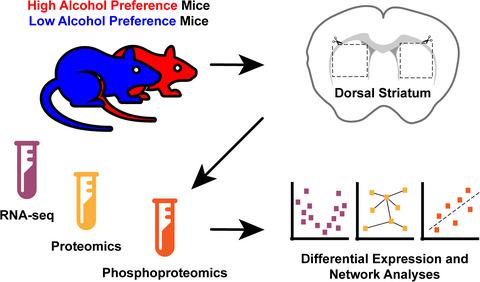当前位置:
X-MOL 学术
›
J. Neurochem.
›
论文详情
Our official English website, www.x-mol.net, welcomes your feedback! (Note: you will need to create a separate account there.)
A multi-omic analysis of the dorsal striatum in an animal model of divergent genetic risk for alcohol use disorder
Journal of Neurochemistry ( IF 4.7 ) Pub Date : 2020-10-27 , DOI: 10.1111/jnc.15226 Gregory G Grecco 1, 2 , David L Haggerty 1 , Emma H Doud 3 , Brandon M Fritz 1 , Fuqin Yin 1 , Hunter Hoffman 1 , Amber L Mosley 3 , Edward Simpson 4 , Yunlong Liu 4 , Anthony J Baucum 1, 5, 6 , Brady K Atwood 1, 6
Journal of Neurochemistry ( IF 4.7 ) Pub Date : 2020-10-27 , DOI: 10.1111/jnc.15226 Gregory G Grecco 1, 2 , David L Haggerty 1 , Emma H Doud 3 , Brandon M Fritz 1 , Fuqin Yin 1 , Hunter Hoffman 1 , Amber L Mosley 3 , Edward Simpson 4 , Yunlong Liu 4 , Anthony J Baucum 1, 5, 6 , Brady K Atwood 1, 6
Affiliation

|
The development of selectively bred high and low alcohol-preferring mice (HAP and LAP, respectively) has allowed for an assessment of the polygenetic risk for pathological alcohol consumption and phenotypes associated with alcohol use disorder (AUD). Accumulating evidence indicates that the dorsal striatum (DS) is a central node in the neurocircuitry underlying addictive processes. Therefore, knowledge of differential gene, protein, and phosphorylated protein expression in the DS of HAP and LAP mice may foster new insights into how aberrant DS functioning may contribute to AUD-related phenotypes. To begin to elucidate these basal differences, a complementary and integrated analysis of DS tissue from alcohol-naïve male and female HAP and LAP mice was performed using RNA sequencing, quantitative proteomics, and phosphoproteomics. These datasets were subjected to a thorough analysis of gene ontology, pathway enrichment, and hub gene assessment. Analyses identified 2,108, 390, and 521 significant differentially expressed genes, proteins, and phosphopeptides, respectively between the two lines. Network analyses revealed an enrichment in the differential expression of genes, proteins, and phosphorylated proteins connected to cellular organization, cytoskeletal protein binding, and pathways involved in synaptic transmission and functioning. These findings suggest that the selective breeding to generate HAP and LAP mice may lead to a rearrangement of synaptic architecture which could alter DS neurotransmission and plasticity differentially between mouse lines. These rich datasets will serve as an excellent resource to inform future studies on how inherited differences in gene, protein, and phosphorylated protein expression contribute to AUD-related phenotypes.
中文翻译:

酒精使用障碍不同遗传风险动物模型中背侧纹状体的多组学分析
选择性繁育的高和低酒精偏好小鼠(分别为 HAP 和 LAP)的发展允许评估与酒精使用障碍 (AUD) 相关的病理性饮酒和表型的多基因风险。越来越多的证据表明,背侧纹状体 (DS) 是成瘾过程中神经回路的中心节点。因此,了解 HAP 和 LAP 小鼠 DS 中的差异基因、蛋白质和磷酸化蛋白表达可能会促进对异常 DS 功能如何导致 AUD 相关表型的新见解。为了开始阐明这些基本差异,使用 RNA 测序、定量蛋白质组学和磷酸化蛋白质组学对未饮酒的雄性和雌性 HAP 和 LAP 小鼠的 DS 组织进行了补充和综合分析。这些数据集对基因本体、通路富集和中心基因评估进行了彻底的分析。分析确定了两条线之间分别有 2,108、390 和 521 个显着差异表达的基因、蛋白质和磷酸肽。网络分析揭示了与细胞组织、细胞骨架蛋白结合以及参与突触传递和功能的通路相关的基因、蛋白质和磷酸化蛋白质的差异表达。这些发现表明,产生 HAP 和 LAP 小鼠的选择性育种可能导致突触结构的重新排列,这可能会改变小鼠品系之间的 DS 神经传递和可塑性差异。这些丰富的数据集将作为一个极好的资源,为未来关于基因遗传差异的研究提供信息,
更新日期:2020-10-27
中文翻译:

酒精使用障碍不同遗传风险动物模型中背侧纹状体的多组学分析
选择性繁育的高和低酒精偏好小鼠(分别为 HAP 和 LAP)的发展允许评估与酒精使用障碍 (AUD) 相关的病理性饮酒和表型的多基因风险。越来越多的证据表明,背侧纹状体 (DS) 是成瘾过程中神经回路的中心节点。因此,了解 HAP 和 LAP 小鼠 DS 中的差异基因、蛋白质和磷酸化蛋白表达可能会促进对异常 DS 功能如何导致 AUD 相关表型的新见解。为了开始阐明这些基本差异,使用 RNA 测序、定量蛋白质组学和磷酸化蛋白质组学对未饮酒的雄性和雌性 HAP 和 LAP 小鼠的 DS 组织进行了补充和综合分析。这些数据集对基因本体、通路富集和中心基因评估进行了彻底的分析。分析确定了两条线之间分别有 2,108、390 和 521 个显着差异表达的基因、蛋白质和磷酸肽。网络分析揭示了与细胞组织、细胞骨架蛋白结合以及参与突触传递和功能的通路相关的基因、蛋白质和磷酸化蛋白质的差异表达。这些发现表明,产生 HAP 和 LAP 小鼠的选择性育种可能导致突触结构的重新排列,这可能会改变小鼠品系之间的 DS 神经传递和可塑性差异。这些丰富的数据集将作为一个极好的资源,为未来关于基因遗传差异的研究提供信息,



























 京公网安备 11010802027423号
京公网安备 11010802027423号